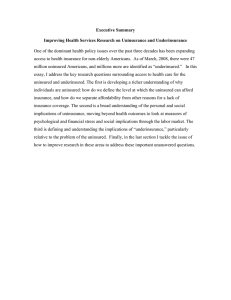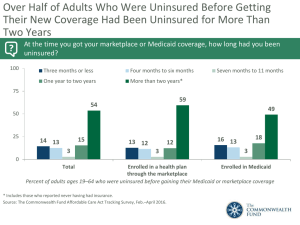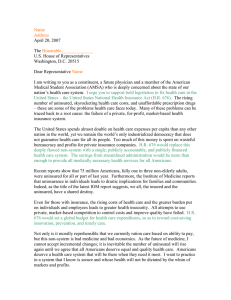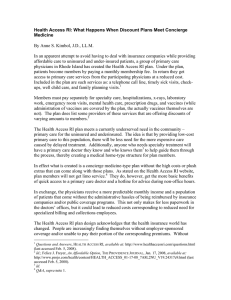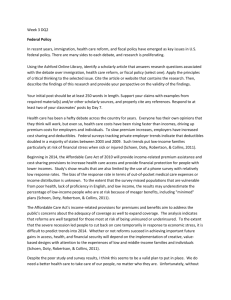Rising Health Care Costs: Implications for the Health and
advertisement
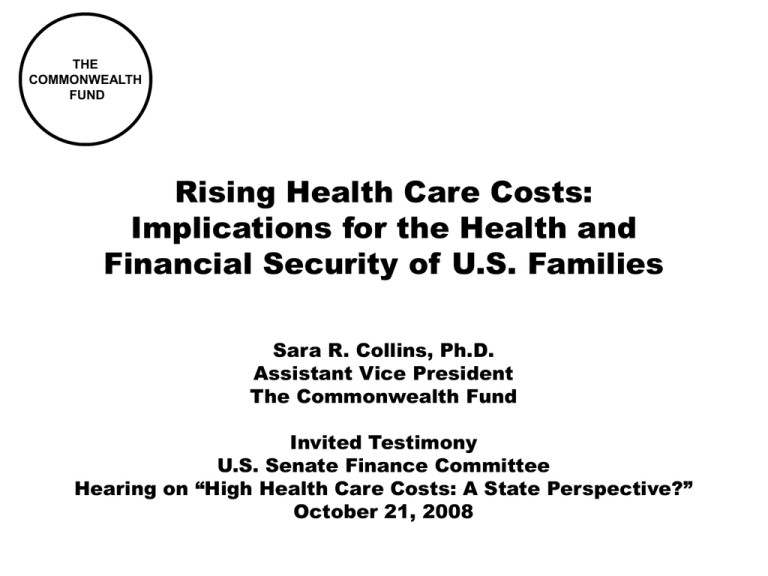
THE COMMONWEALTH FUND Rising Health Care Costs: Implications for the Health and Financial Security of U.S. Families Sara R. Collins, Ph.D. Assistant Vice President The Commonwealth Fund Invited Testimony U.S. Senate Finance Committee Hearing on “High Health Care Costs: A State Perspective?” October 21, 2008 Figure 1. 116 Million Working-Age Adults Were Uninsured, Underinsured, Reported a Medical Bill Problem and/or Did Not Access Needed Health Care Because of Cost, 2007 Adequate coverage and no bill problem or problem getting needed care due to cost 61 million 35% Uninsured anytime during the year or underinsured 18 million 10% Medical bill/ debt problem 18 million 10% Medical bill/debt problem and did not get needed care due to cost 54 million 31% Did not get needed care due to cost 26 million 15% 177 Million Adults, Ages 19–64 Source: S. R. Collins, J. L. Kriss, M. M. Doty and S. D. Rustgi, Losing Ground: How the Loss of Adequate Health Insurance Is Burdening Working Families, The Commonwealth Fund, August 2007. Figure 2. International Comparison of Spending on Health, 1980–2005 Average spending on health per capita ($US PPP) 7000 6000 United States Germany Canada France Australia United Kingdom Total expenditures on health as percent of GDP 16 14 5000 12 4000 10 8 3000 6 2000 4 19 80 19 82 19 84 19 86 19 88 19 90 19 92 19 94 19 96 19 98 20 00 20 02 20 04 0 2 0 19 80 19 82 19 84 19 86 19 88 19 90 19 92 19 94 19 96 19 98 20 00 20 02 20 04 1000 United States Germany Canada France Australia United Kingdom Source: Commonwealth Fund National Scorecard on U.S. Health System Performance, 2006. Updated data from OECD Health Data 2007. Figure 3. Americans Spend More Out-of-Pocket on Health Care Expenses Than Citizens in Other Industrialized Countries Total health care spending per capita (US$) 7000 6000 United States 5000 4000 3000 France 2000 Netherlands Germany1 New Zealand 1000 Canada OECD Median Japan Australia2 0 0 100 200 300 400 500 600 700 800 900 Out-of-pocket health care spending per capita (US$) 1 2003 2003 Total Health Care spending, 2002 OOP Spending Source: J. Cylus and G. F. Anderson, Multinational Comparisons of Health Systems Data, 2006, The Commonwealth Fund, May 2007. 2 Figure 4. Increases in Health Insurance Premiums Compared with Other Indicators, 1988–2007 Percent Health insurance premiums 20 18.0 15 Workers’ earnings Overall inflation National health expenditures per capita 12.9* 12.0 11.2* 9.2* 7.7* 6.1* 10.9* 10 8.2* 8.5 5.3* 5 13.9^ 4.7* 0.8 0 1988 1990 1992 1994 1996 1998 2000 2002 2004 2006 2008 * Estimate is statistically different from the previous year shown at p<0.05. ^ Estimate is statistically different from the previous year shown at p<0.1. Note: Data on premium increases reflect the cost of health insurance premiums for a family of four. Historical estimates of workers’ earnings have been updated to reflect new industry classifications (NAICS). Source: G. Claxton, J. Gabel et al., "Health Benefits In 2008: Premiums Moderately Higher, While Enrollment In Consumer-Directed Plans Rises In Small Firms," Health Affairs, Sept./Oct. 2008 27(6): w492-502. Kaiser/HRET Survey of Employer-Sponsored Health Benefits, 2008. S. Keehan, A. Sisko et al., “Health Spending Projections Through 2017: The Baby-Boom Generation Is Coming to Medicare,” Health Affairs, March/April 2008 27(2):w145–w155. Figure 5. Employer Coverage Continues to Be Major Source of Coverage for Employees of Larger Firms But Has Declined Among Small Firms Percent of firms offering health benefits 2000 100 75 69 2008 91 90 97 94 99 99 80 78 63 50 57 49 25 0 Total 3–9 10–24 25–49 50–199 200+ workers workers workers workers workers Source: The Kaiser Family Foundation/Health Research and Educational Trust, Employer Health Benefits, 2000 and 2008 Annual Surveys. Figure 6. Employer-Provided Health Insurance, by Income Quintile, 2000–2006 Percent of population under age 65 with health benefits from employer 100% 80% 60% 88% 88% 87% 86% 85% 84% 77% 77% 62% 60% 75% 57% 87% 84% 74% 87% 83% 74% 87% 82% 72% 86% 82% Highest quintile Fourth 72% Third 55% 54% 54% 53% 40% 29% 26% 25% 23% 23% 20% 22% 22% Second Lowest quintile 0% 2000 2001 2002 2003 2004 2005 2006 Source: Analysis of the March Current Population Survey, 2001–07, by Elise Gould, Economic Policy Institute. Figure 7. Deductibles Rise Sharply, Especially in Small Firms, 2000–2008 Mean deductible for single coverage (PPO, in-network) 917 $1,000 2000 2008 $750 560 413 $500 $250 187 210 157 $0 Total Small firms, 3–199 Large firms, 200+ employees employees PPO = preferred provider organization. PPOs covered 57 percent of workers enrolled in an employer-sponsored health insurance plan in 2007. Source: The Kaiser Family Foundation/Health Research and Educational Trust, Employer Health Benefits, 2000 and 2007 Annual Surveys. Figure 8. High Out-of-Pocket Spending Climbs Across Income Groups, 2001–2007 Percent of adults ages 19–64 who spent 10% or more of income annually on out-of-pocket costs and premiums 75 2001 2007 53 50 33 25 21 35 36 36 26 18 17 10 0 Total Low income Moderate Middle income High income income Note: Income refers to annual income. In 2001 low income is <$20,000, moderate income is $20,000–$34,999, middle income is $35,000–$59,999, and high income is $60,000 or more. In 2007, low income is <$20,000, moderate income is $20,000–$39,999, middle income is $40,000–$59,999, and high income is $60,000 or more. Source: S. R. Collins, J. L. Kriss, M. M. Doty and S. D. Rustgi, Losing Ground: How the Loss of Adequate Health Insurance Is Burdening Working Families, The Commonwealth Fund, August 2007. Figure 9. Forty-Six Million Uninsured in 2007; Increase of 7.2 Million Since 2000 Number of uninsured, in millions 50 40 38 40 2000 2001 42 43 43 45 47 46 2002 2003 2004 2005 2006 2007 30 20 10 0 Source: U.S. Census Bureau, March Current Population Survey, 2001–2008. Figure 10. Individual Market Is Not an Affordable Option for Many People Adults ages 19–64 with individual coverage or who thought about or tried to buy it in past three years who: Total Health problem No health problem <200% poverty 200%+ poverty 34% 48% 24% 43% 29% Found it very difficult or impossible to find affordable coverage 58 71 48 72 50 Were turned down or charged a higher price because of a pre-existing condition 21 33 12 26 18 Never bought a plan 89 92 86 93 86 Found it very difficult or impossible to find coverage they needed Source: S. R. Collins, J. L. Kriss, K. Davis, M. M. Doty, and A. L. Holmgren, Squeezed: Why Rising Exposure to Health Care Costs Threatens the Health and Financial Well Being of American Families, The Commonwealth Fund, September 2006. Figure 11. The Number of Underinsured Adults Under Age 65 Rose to 25 Million in 2007, Up from 16 Million in 2003 Percent of adults ages 19–64 Underinsured* Uninsured during year 100 80 68 60 40 20 35 9 42 19 72 24 14 26 28 2003 2007 49 48 0 Total 2003 2007 Under 200% of poverty 17 4 13 2003 27 11 16 2007 At or above 200% of poverty *Underinsured defined as insured all year but experienced one of the following: medical expenses equaled 10% or more of income; medical expenses equaled 5% or more of income if low-income (<200% of poverty); or deductibles equaled 5% or more of income. Source: C. Schoen, S. R. Collins, J. L. Kriss, and M. M. Doty, “How Many Are Underinsured? Trends Among U.S. Adults, 2003 and 2007,” Health Affairs Web Exclusive, June 10, 2008. Data: Commonwealth Fund Biennial Health Insurance Surveys (2003 and 2007). Figure 12. Health Plan Characteristics of Privately Insured Adults, 2007 Percent of adults (ages 19–64) Insured, not underinsured 50 41 40 30 26 20 10 Underinsured 19 14 8 5 0 Deductible $1,000 or more Premium is 5% or more of Premium is 10% or more of family income family income Source: C. Schoen, S. R. Collins, J. L. Kriss, and M. M. Doty, “How Many are Underinsured? Trends Among U.S. Adults, 2003 and 2007,” Health Affairs Web Exclusive, June 10, 2008. Data: 2007 Commonwealth Fund Biennial Health Insurance Survey. Figure 13. Cost-Related Problems Getting Needed Care Have Increased Across All Income Groups, 2001–2007 Percent of adults ages 19–64 who had any of four access problems* in past year because of cost 2001 75 62 50 45 41 2007 58 43 40 29 29 24 25 14 0 Total Low income Moderate Middle income High income income * Did not fill a prescription; did not see a specialist when needed; skipped recommended medical test, treatment, or follow-up; had a medical problem but did not visit doctor or clinic. Note: Income refers to annual income. In 2001 and 2003 low income is <$20,000, moderate income is $20,000–$34,999, middle income is $35,000–$59,999, and high income is $60,000 or more. In 2005 and 2007, low income is <$20,000, moderate income is $20,000–$39,999, middle income is $40,000–$59,999, and high income is $60,000 or more. Source: S. R. Collins, J. L. Kriss, M. M. Doty and S. D. Rustgi, Losing Ground: How the Loss of Adequate Health Insurance Is Burdening Working Families, The Commonwealth Fund, August 2007. Figure 14. Uninsured and Underinsured Adults Report High Rates of Cost-Related Problems Getting Needed Care Percent of adults ages 19–64 who had cost-related access problems in the past 12 months Total Insured all year, not underinsured Insured all year, underinsured Insured now, time uninsured in past year 60 57 Uninsured now 75 54 46 50 45 37 39 31 25 19 45 47 24 20 9 34 25 13 42 31 7271 60 45 29 15 0 Did not fill a Did not see Skipped Had medical Any of the four prescription specialist medical test, problem, did access when needed treatment, or not see doctor problems follow-up or clinic Source: S. R. Collins, J. L. Kriss, M. M. Doty and S. D. Rustgi, Losing Ground: How the Loss of Adequate Health Insurance Is Burdening Working Families, The Commonwealth Fund, August 2007. Figure 15. Uninsured and Underinsured Adults with Chronic Conditions Are More Likely to Visit the ER for Their Conditions Percent of adults ages 19–64 with at least one chronic condition* Total Insured all year, not underinsured Insured all year, underinsured Insured now, time uninsured in past year Uninsured now 75 62 64 46 50 33 25 43 32 26 15 33 19 0 Skipped doses or did not fill Visited ER, hospital, or both for prescription for chronic condition chronic condition because of cost* *Adults with at least one chronic condition who take prescription medications on a regular basis. Source: S. R. Collins, J. L. Kriss, M. M. Doty and S. D. Rustgi, Losing Ground: How the Loss of Adequate Health Insurance Is Burdening Working Families, The Commonwealth Fund, August 2007. Figure 16. Chronic Disease Under Control: Diabetes and Hypertension National Average By Insurance, 1999–2004 Percent of adults (age 18+) 1999-2000 100 Insured 2003-2004 Uninsured 88 81 79 75 63 50 41 41 31 21 25 0 Diabetes under control* High blood pressure under control** Diabetes under High blood pressure control* under control** *Refers to diabetic adults whose HbA1c is <9.0 **Refers to hypertensive adults whose blood pressure is <140/90 mmHg. Data: J. M. McWilliams, Harvard Medical School analysis of National Health and Nutrition Examination Survey. Source: Commonwealth Fund National Scorecard on U.S. Health System Performance, 2008. Figure 17. Previously Uninsured Medicare Beneficiaries with History of Cardiovascular Disease or Diabetes Have Much Higher Self-Reported Hospital Admissions After Entering Medicare Than Previously Insured Number of hospital admissions per two-year period Uninsured before age 65 Continuously insured before age 65 0.7 0.6 0.5 0.4 0.3 0.2 0.1 0 58 60 62 64 66 68 70 Source: J. M. McWilliams, E. Meara, A. M. Zaslavsky et al., “Use of Health Services by Previously Uninsured Medicare Beneficiaries,” New England Journal of Medicine, July 12, 2007 357(2):143–53. 72 Figure 18. Medical Bill Problems and Accrued Medical Debt, 2005–2007 Percent of adults ages 19–64 2005 2007 Had problems paying or unable to pay medical bills 23% 39 million 27% 48 million Contacted by collection agency for unpaid medical bills 13% 22 million 16% 28 million Had to change way of life to pay bills 14% 24 million 18% 32 million Any of the above bill problems 28% 48 million 33% 59 million Medical bills being paid off over time 21% 37 million 28% 49 million Any bill problems or medical debt 34% 58 million 41% 72 million In the past 12 months: Source: S. R. Collins, J. L. Kriss, M. M. Doty and S. D. Rustgi, Losing Ground: How the Loss of Adequate Health Insurance Is Burdening Working Families, The Commonwealth Fund, August 2007. Figure 19. Problems with Medical Bills or Accrued Medical Debt Increased, 2005–2007 Percent of adults ages 19–64 with medical bill problems or accrued medical debt 2005 75 53 50 34 41 43 2007 56 48 32 25 39 20 25 0 Total Low income Moderate Middle income High income income Note: Income refers to annual income. In 2005 and 2007, low income is <$20,000, moderate income is $20,000–$39,999, middle income is $40,000–$59,999, and high income is $60,000 or more. Source: S. R. Collins, J. L. Kriss, M. M. Doty and S. D. Rustgi, Losing Ground: How the Loss of Adequate Health Insurance Is Burdening Working Families, The Commonwealth Fund, August 2007. Figure 20. Sixty Percent of Underinsured or Uninsured Adults Reported Medical Bill Problems or Debt Percent of adults ages 19–64 with medical bill problems or accrued medical debt Total Insured all year, not underinsured Insured all year, underinsured Insured now, time uninsured in past year Uninsured now 75 51 50 25 43 47 47 31 27 23 13 61 6260 31 29 27 16 8 34 39 35 28 41 26 19 18 8 0 Not able to pay Contacted by Had to change medical bills collection way of life to agency* pay medical bills Medical bills/ Any medical debt being paid bill problem or off over time outstanding debt * Includes only those individuals who had a bill sent to a collection agency when they were unable to pay it. Source: S. R. Collins, J. L. Kriss, M. M. Doty and S. D. Rustgi, Losing Ground: How the Loss of Adequate Health Insurance Is Burdening Working Families, The Commonwealth Fund, August 2007. Figure 21. Uninsured Adults Are More Likely to Be Paying Off Large Amounts of Medical Debt Over Time Percent of adults ages 19–64 who are paying off medical bills over time Uninsured Anytime in Past Year Total Insured all year Insured now, time uninsured in past year Uninsured now 51% 57% 46% 38% $2,000–$3,999 21 20 25 22 $4,000–$7,999 12 11 11 14 $8,000 or more 12 9 13 20 Past year 54 57 53 43 Earlier year 37 38 37 44 8 7 9 12 How much are the medical bills that are being paid off over time? Less than $2,000 Was this for care received in past year or earlier? Both Source: S. R. Collins, J. L. Kriss, M. M. Doty and S. D. Rustgi, Losing Ground: How the Loss of Adequate Health Insurance Is Burdening Working Families, The Commonwealth Fund, August 2007. Figure 22. More Than One-Quarter of Adults Under Age 65 with Medical Bill Burdens and Debt Were Unable to Pay for Basic Necessities Percent of adults ages 19–64 with medical bill problems or accrued medical debt Insured All Year Uninsured Anytime During Year Total No underinsured indicators 29% 16% 29% 42% 40% Used up all of savings 39 26 46 46 47 Took out a mortgage against your home or took out a loan 10 9 12 11 11 Took on credit card debt 30 28 33 34 26 Insured at time care was provided 61 80 82 46 24 Percent of adults reporting: Unable to pay for basic necessities (food, heat, or rent) because of medical bills Insured now, Uninsured Underinsured time uninsured now in past year Source: S. R. Collins, J. L. Kriss, M. M. Doty and S. D. Rustgi, Losing Ground: How the Loss of Adequate Health Insurance Is Burdening Working Families, The Commonwealth Fund, August 2007. Figure 23. Adults with Medical Bill Problems Report High Rates of Cost-Related Problems Getting Needed Care Percent of adults ages 19–64 who had the following problems in the past year 100 No bill or debt problem Any bill and/or debt problem 75 75 56 48 50 25 57 39 25 14 10 13 6 0 Did not fill a Skipped a Had medical Did not see Any of four prescription medical test, problem, did specialist access treatment or not see doctor when needed problems follow-up or clinic Source: The Commonwealth Fund Biennial Health Insurance Survey, 2007. Figure 24. Policy Options and Distribution of 10-Year Impact on Spending Across Payer Groups (in billions) Total NHE* Federal Government State/Local Government Private Payer Households 1. Promoting Health Information Technology –$88 –$41 –$19 $0 –$27 2. Center for Medical Effectiveness and Health Care Decision-Making –$368 –$114 –$49 –$98 –$107 –$9 –$8 $0 $0 –$1 4. Public Health: Reducing Tobacco Use –$191 –$68 –$35 –$39 –$49 5. Public Health: Reducing Obesity –$283 –$101 –$52 –$57 –$73 6. Positive Incentives for Health –$19 $2 –$12 –$4 –$5 7. Hospital Pay-for-Performance –$34 –$27 –$1 –$2 –$4 8. Episode-of-Care Payment –$229 –$377 $18 $90 $40 9. Strengthening Primary Care and Care Coordination –$194 –$157 –$4 –$9 –$23 –$131 –$186 –$19 –$55 $130 11. Reset Benchmark Rates for Medicare Advantage Plans –$50 –$124 $0 $0 $74 12. Competitive Bidding –$104 –$283 $0 $0 $178 13. Negotiated Prescription Drug Prices –$43 –$72 $4 $17 $8 14. All-Payer Provider Payment Methods and Rates –$122 $0 $0 –$105 –$18 15. Limit Payment Updates in High-Cost Areas –$158 –$260 $13 $62 $27 Producing and Using Better Information 3. Patient Shared Decision-Making Promoting Health and Disease Prevention Aligning Incentives with Quality and Efficiency 10. Limit Federal Tax Exemptions for Premium Contributions Correcting Price Signals in the Health Market Note: A negative number indicates spending decreases compared with projected expenditures (i.e., savings); a positive indicates spending increases. * In some cases, because of rounding, the sum of the payer group impact does not add up to the national health expenditures total. Source: C. Schoen, S. Guterman, A. Shih et al., Bending the Curve: Options for Achieving Savings and Improving Value in U.S. Health Spending (New York: The Commonwealth Fund, December 2007). Figure 25. Savings Can Offset Federal Costs of Insurance for All: Federal Spending Under Two Scenarios Dollars in billions Federal spending under Building Blocks alone Net federal with Building Blocks plus savings options* $250 $205 $200 $150 $100 $50 $122 $82 $31 $13 $10 $0 2008 2012 2017 * Selected options include improved information, payment reform, and public health. Data: Lewin Group estimates of combination options compared with projected federal spending under current policy. Source: Schoen et al., Bending the Curve: Options for Achieving Savings and Improving Value in U.S. Health Spending (New York: The Commonwealth Fund, December 2007).
